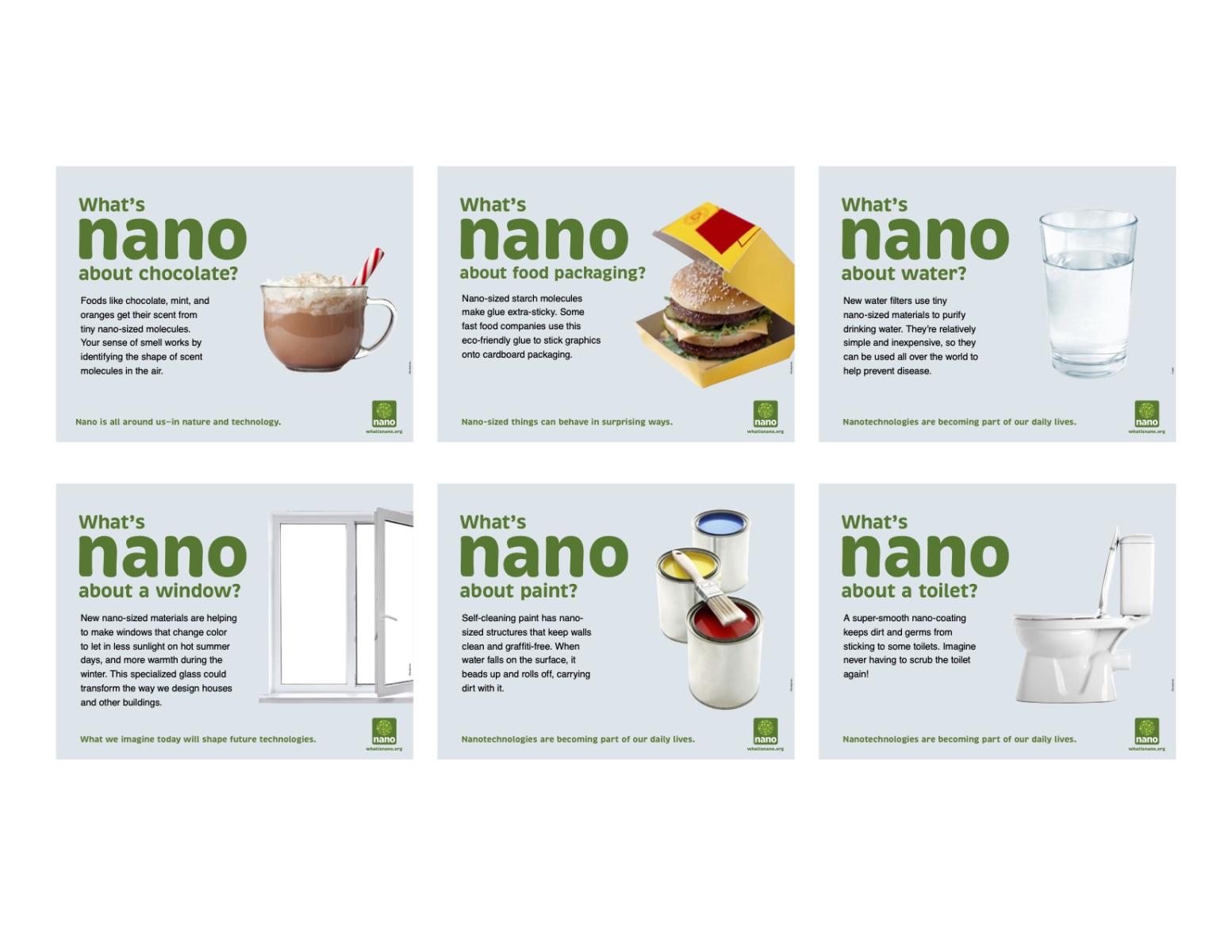DESCRIPTION
This series of museum labels are designed for general use in your museum or institution to highlight existing connections to nanoscale science, engineering, or technology. NISE Net partners are already coming up with creative ways to use these labels to showcase nano. For example, you can make a scavenger hunt or special tour to encourage visitors to find all the connections! Additional templates (.doc and .indd) are also provided so that you can create your own signage and content.
Signs include: chocolate, food packaging, water, a window, paint, a toilet, a soap bubble, fashion, a sock, a pencil, a butterfly, a gecko, a laptop, an elevator, and a local city.
DESCRIPTION
This series of museum labels are designed for general use in your museum or institution to highlight existing connections to nanoscale science, engineering, or technology. NISE Net partners are already coming up with creative ways to use these labels to showcase nano. For example, you can make a scavenger hunt or special tour to encourage visitors to find all the connections! Additional templates (.doc and .indd) are also provided so that you can create your own signage and content.
Signs include: chocolate, food packaging, water, a window, paint, a toilet, a soap bubble, fashion, a sock, a pencil, a butterfly, a gecko, a laptop, an elevator, and a local city.
OBJECTIVES
BIG IDEA
Nano is part of many different fields of scientific study, and nanotechnologies and phenomena connect to a variety of existing and future products and natural objects.
LEARNING GOALS
Nano sized things can behave in surprising ways. Nano is all around us, in nature and in technology. Nanotechnologies are becoming part of our daily lives. What we imagine today will shape future technologies.
NANO CONTENT MAP
Nanometer-sized things are very small, and often behave differently than larger things do.
Scientists and engineers have formed the interdisciplinary field of nanotechnology by investigating properties and manipulating matter at the nanoscale.
Nanoscience, nanotechnology, and nanoengineering lead to new knowledge and innovations that weren't possible before.
Nanotechnologies—and their costs, utility, risks, and benefits—are closely interconnected with society and with our values.
DOWNLOAD FILES
- Museum Labels, Thumbnails (PDF)
- Museum Labels (PDF)
- Museum Label Template, 4 (DOC)
- Museum Label Template, 3 (DOC)
- Museum Label Template, 2 (DOC)
- Museum Label Template, 1 (DOC)
- Museum Labels Template, (INDD)
- Museum Labels, Thumbnails (Spanish) (PDF)
- Museum Labels (Spanish) (PDF)
- Museum Label Template, 4 (Spanish) (DOC)
- Museum Label Template, 3 (Spanish) (DOC)
- Museum Label Template, 2 (Spanish) (DOC)
- Museum Label Template, 1 (Spanish) (DOC)
Credits
Sciencenter
Developed for the NISE Network with funding from the National Science Foundation under Award Numbers 0532536 and 0940143. Any opinions, findings, and conclusions or recommendations expressed in this product are those of the authors and do not necessarily reflect the views of the Foundation.
Creative Commons Attribution Non-Commercial Share Alike 3.0 United States (CC BY-NC-SA 3.0 US).
View more details

NISE Network products are developed through an iterative collaborative process that includes scientific review, peer review, and visitor evaluation in accordance with an inclusive audiences approach. Products are designed to be easily edited and adapted for different audiences under a Creative Commons Attribution Non-Commercial Share Alike license. To learn more, visit our Development Process page.





